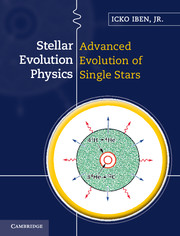Book contents
- Frontmatter
- Contents
- Preface
- Part IV Transport processes, weak interaction processes, and helium-burning reactions
- 12 Particle diffusion and gravitational settling
- 13 Heat conduction by electrons
- 14 Beta decay and electron capture in stars at high densities
- 15 Current–current weak interactions and the production of neutrino–antineutrino pairs
- 16 Helium-burning nuclear reactions and energy-generation rates
- Part V Evolution during helium-burning phases
- Part VI Terminal evolution of low and intermediate mass stars
- Index
- References
15 - Current–current weak interactions and the production of neutrino–antineutrino pairs
from Part IV - Transport processes, weak interaction processes, and helium-burning reactions
Published online by Cambridge University Press: 05 December 2012
- Frontmatter
- Contents
- Preface
- Part IV Transport processes, weak interaction processes, and helium-burning reactions
- 12 Particle diffusion and gravitational settling
- 13 Heat conduction by electrons
- 14 Beta decay and electron capture in stars at high densities
- 15 Current–current weak interactions and the production of neutrino–antineutrino pairs
- 16 Helium-burning nuclear reactions and energy-generation rates
- Part V Evolution during helium-burning phases
- Part VI Terminal evolution of low and intermediate mass stars
- Index
- References
Summary
By the end of the third decade of the twentieth century, it had become clear that, in nuclear beta-decay events, beta particles are emitted in a continuous energy spectrum rather than with a unique energy equal to the change in energy of the emitting nucleus (although the maximum energy of the beta particle is equal to the change in nuclear energy), that the change in the electrical charge of the nucleus is exactly equal in absolute value but of opposite sign to the charge of the emitted beta particle, and that beta decay events often involve a unit change in the spin of the nucleus. In 1930, Wolfgang Pauli began communicating to other physicists the idea that, in order to account for these facts, another, previously unknown, “penetrating” particle must also be emitted in beta decay events with the properties: mass much smaller than the electron mass, no electrical charge, and an intrinsic spin equal to that of the electron. According to M. Mladjenović (1998), for over three years Pauli considered the idea too speculative to publish, and his first formal account appeared in the proceedings of an international conference on physics held in London in 1934. Enrico Fermi dubbed the hypothetical particle the “neutrino” (little neutral one) and formulated a mathematical theory of beta interactions involving neutrinos (Fermi, 1934) which has guided experimental and theoretical work on the weak interaction up to the present time.
- Type
- Chapter
- Information
- Stellar Evolution Physics , pp. 1011 - 1069Publisher: Cambridge University PressPrint publication year: 2012



